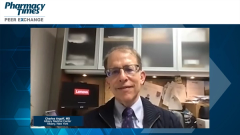
Unmet Needs and the Impact of COVID-19 on the Opioid Crisis
Experts discuss opioid crisis complexities, such as the able to manage pain appropriately and the impact of social and structural determinates of health.
Episodes in this series

Peter Salgo, MD: It is not the opioid, it is what are we going to do about pain, which has always been a problem for physicians, nurses, and nurse practitioners—pain is bad, so we make pain go away.
Joshua Lynch, DO, EMT-P, FAAEM, FACEP: Dr Salgo, we saw a lot of frustration in the emergency department when patients would come in when their pain management doctor stopped prescribing opioids for them or discharged them from the practice. The worst case scenario, which happens frequently, is that the pain management practice is shut down for irregular behavior or prescribing,
whatever the cause is, and those patients ultimately find themselves at the emergency department as their next stop. I think a lot of the frustration comes from, and where patients could get lost through the cracks, is the fact that emergency departments typically haven’t been prepared to handle pain management appropriately or handle someone with opioid-use disorder or where to send them.
We have learned a lot about that recently. I think we have gained some understanding and infrastructure about where to send patients who fall into those 2 categories.
Peter Salgo, MD: I do not want to get off this topic before we mention the 800-pound gorilla in the room. We are all on Zoom. The reason we are all on Zoom today is because the COVID-19 pandemic is out there. How has COVID-19 impacted all of this?
Charles Argoff, MD: Actually, there are more patients overdosing on these nonprescription opioids than ever before. I would like to say one other thing, which is another gorilla in the room as well, of its own sort. I think Theresa made this point earlier or alluded to this—the CDC guideline was misinterpreted as being a guideline that said opioids are always bad. In fact, the CDC, after its guideline publication in 2016, published an almost apologetic kind of article in The New England Journal of Medicine about a year or so ago. It said, “We did not intend for people to be cut off.” That adds to the complexity of what you are hearing from us.
Peter Salgo, MD: If you were to list the unmet needs of patients here in the midst of this opioid crisis, what are the bullet points you’d list? What are we looking at?
Jeffrey Bratberg, PharmD, FAPhA: I would say the unmet needs of our patients are what the COVID-19 crisis has laid bare: social and structural determinates of health. We see that these factors are what have divided the COVID-19 crisis. Patients who are Black are 3 times more at risk of dying of COVID-19. We see disparities in overdose deaths, overdose inpatient admissions, and emergency department admissions. Just this week the CDC came out saying that there is a greater geographic distribution of opioids. Some of you are on the West Coast, where there are massive, multihundred percent increases in synthetic opioids. This is an illegal opioid crisis. It is definitely a fentanyl crisis, and it is a polysubstance crisis. This is a crisis of people who literally cannot make ends meet; they are essential workers, they are not provided testing, and they are not provided vaccines now. There are all those disparities that have always existed in health care.
We see disparities in opioid prescriptions by employment. We see that people were not only getting overexposed to opioids in the first wave of the crisis, but then they got cut off because of CDC guidelines or a misinterpretation of them, or pharmacies—you name it, we are all at fault in that—and switched to heroin. Heroin became not pure enough, and now it is fentanyl that people use. Now with COVID-19, the fentanyl is even more dangerous and more potent because this is what happens when you cut off supplies and put people into crisis.
Transcript edited for clarity.
Newsletter
Stay informed on drug updates, treatment guidelines, and pharmacy practice trends—subscribe to Pharmacy Times for weekly clinical insights.



















































































































































































































